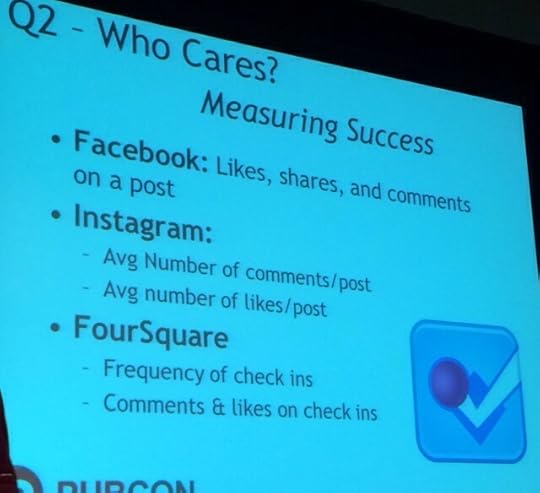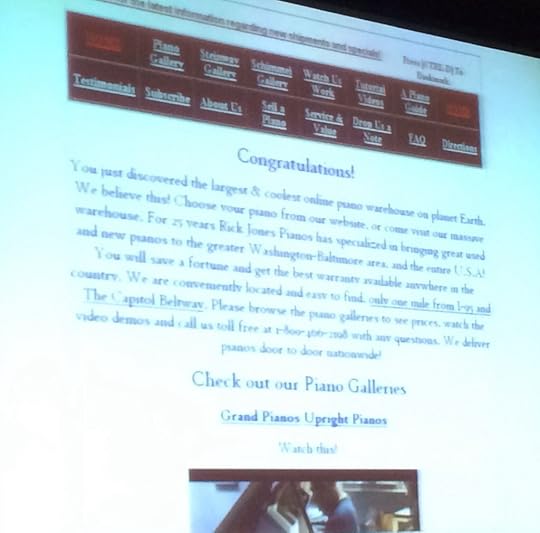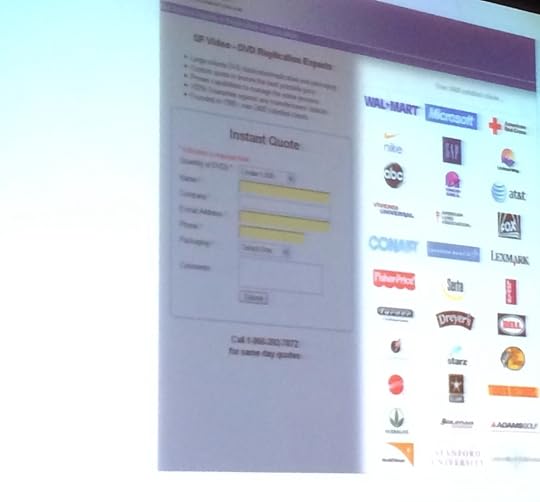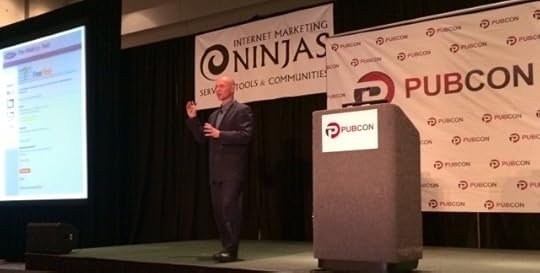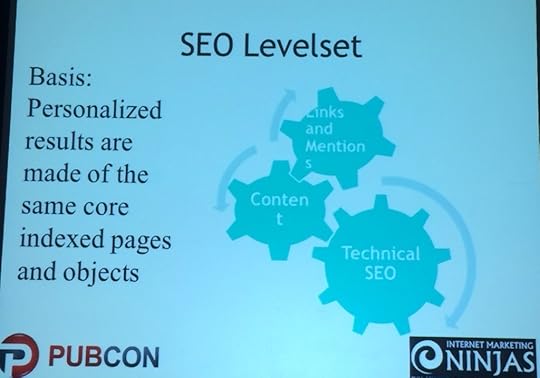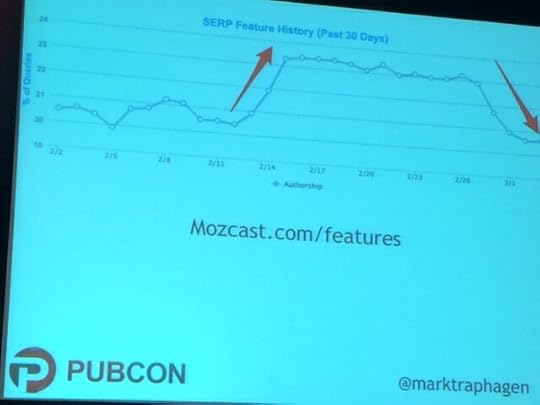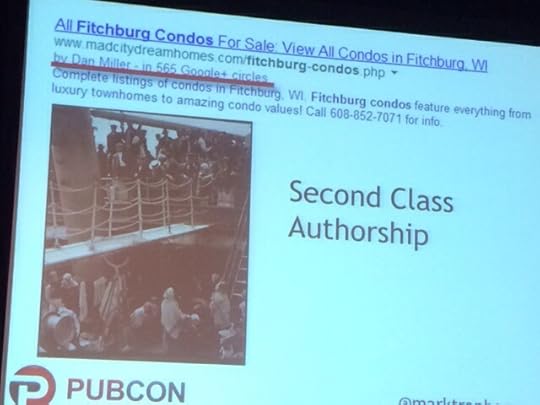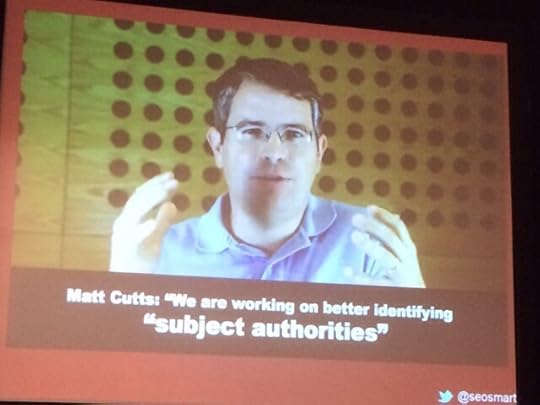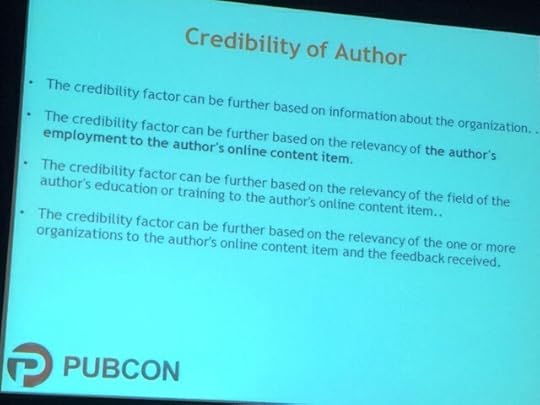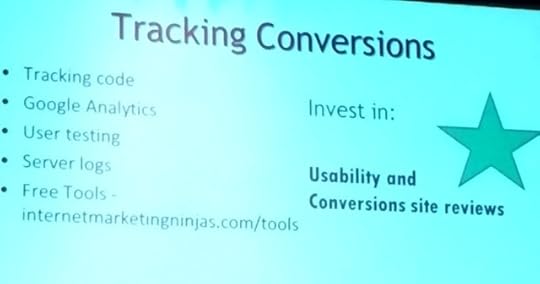Bruce Clay's Blog, page 48
March 24, 2014
30 Smart Online Marketing Tips From SMX West
30 Smart Online Marketing Tips From SMX West was originally published on BruceClay.com, home of expert search engine optimization tips.
It’s hard to adequately describe the balance between awesomeness and intensity that happens at a multi-day search conference like SMX.
With 100-plus speakers presenting about SEO, SMM, and SEM in 60-plus sessions, keynotes and clinics, the amount of insight and tactical information you can take away from an event like SMX — that’s the awesome part. Now, imagine having to choose only 15 out of the 60 sessions to participate in. And imagine having to absorb all the goodness that 15-plus hours of training has to offer.
That’s where the intensity factor comes in.
There’s a lot going on at conferences and it’s simply not possible for one person to catch it all.
For that reason we’ve decided to share with you our 30 greatest takeaways from the 24 sessions we were able to attend at SMX West this year.
And, since there were 30-plus sessions we physically were not able to attend (life is all about decisions, right?), we’re asking for your help! We’d love to add what you learned from SMX West this year to our list of takeaways.
What Was Your Biggest SMX West Takeaway This Year?
We know you have a legal page (or more likely a Drive or Evernote account) full of session notes. What were your biggest SMX West takeaways this year? What’s on your post-conference to do list? What’s the once sentence you heard in a session that shifted your mindset and changed the way you think about online marketing?
SMX is truly a community event and we don’t think there’s any reason why the sharing that happens between sessions and in elevators has to stop just because the conference is over.
Below is our list of 30 actionable SMX West takeaways.
What can you add to the list? Share yours in the comments section below!
30 Online Marketing Tips from 24 SMX West Sessions
1) The key to mobile Big Data: Collect as much data as you can; get permission; monetize it; and then decide how to merge it, mine it, share it, or sell it. (http://bit.ly/1queSUs)
2) Stop griping about content marketing and how much you hate having to become a “media company.” Media first is not a chore! It’s an opportunity to do above and beyond what you ever thought you could accomplish. (http://bit.ly/1gj7WoS)
3) If you’re ever arguing about whether a link is a good link, the conversation is already over. It’s not a good link. If it’s a good link ther shouldn’t be any questions. (http://bit.ly/1pgszTL)
4) If your content matters your audience has to matter even more. If you’re building content, you have to also be building audience. Content marketing is inclusive of audience development. (http://bit.ly/1oKveot)
5) The problem is that our C-Suite stakeholders don’t think of audience as an asset. They still think of marketing as a cost center. We need to make our stakeholders understand that marketing is an asset hub. It’s all about the rise of audience development and a consistency of thought, purpose and action. (http://bit.ly/1oKveot)
6) Twitter is about human communication. Any brand that has an audience they want to connect with can excel on Twitter. It’s all about finding the community, using the tools they’re using, and engaging your community with content that adds value. (http://bit.ly/1lTWTWT)
7) Twitter community coordinators, sales people, and brand managers need to be asking themselves: Can I help five people out per day? Can I join three (or however many) TwitterChats per week? Can I host a meet-up? The trick is to always be thinking of opportunities to engage and participate, and to set goals that help you make that ambition reality. (http://bit.ly/1lTWTWT)
8) Presenting big data to a stakeholder? Make sure you practice your presentation on a nontechnical volunteer to make sure your presentation is easily understood and stakeholder-ready. Seriously. Another approach is to pretend that you’re giving your presentation to your mother, or your neighbor; will they understand what you’re saying? (http://bit.ly/1g6OxTu)
9) The difference between a good analyst and great analysts – getting buy-in to continue analysis! (In other words, communicating with clarity in a way that motivates and conveys impact to stakeholders.) (http://bit.ly/1g6OxTu)
10) Don’t get a case of Audience Assumption Disorder where you put 99% of your effort into creating amazing content and apps and then only 1% into nurturing an audience that will want to see your content. (http://bit.ly/1oKveot)
11) Spend time focusing on proprietary audience development. This means you are not only building an audience, but you are building a proprietary audience that you and you alone can reach. Remember your audience is an asset with predictable downstream value! Don’t forget to invest in that asset as needed. (http://bit.ly/1oKveot)
12) Consider your paid search person (in-house or contract) as a partner; a fellow brand strategist. They need to have a clear picture of the brand’s social, UX and big-picture businesses goals. If you are a paid search person remember you need this information; part a search optimizer’s job is to aggressively find out what success looks like for the business they’re optimizing for. (http://bit.ly/1pgh12B)
13) When clients are seeking out a paid search person they don’t just expect to work with someone who knows keywords and quality score, they want to work with a brand advocate. Someone who can offer perspective, unbiased advice and the ability to explain why things are important. (http://bit.ly/1pgh12B)
14) Wondering how much content you should be creating? According to Rae Hoffman (CEO, PushFire; @sugarrae), there is no cut and dry answer. In 2014 it’s just not as simple as “create four posts a day.” So what do you do? Don’t publish crap just because the calendar says to, publish only when you actually have something to say, and don’t create any content that is mediocre. However much content you can create under those guidelines is enough content. (http://bit.ly/1pgk3nL)
15) Considering working with a new client, or negotiating a contract? Remember these two things: 1) In 2014, your job is more about audience development and business management than “SEO” as we once understood it, and 2) Don’t ever take money if you don’t think you can provide someone with the ROI they deserve. (http://bit.ly/1pgk3nL)
16) Don’t forget to always be looking for exposure opportunities off domain. For instance, Intel looks at the SERP and thinks After someone performs this search, where are they likely to land? If it’s the Best Buy website (because Best Buy is high up in the SERP for a specific keyword phrase), they consider whether it’s smart for them to put an Intel asset (like an ad) on that page to get in front of the consumer after the SERP click. Remember marketing is largely about exposure and the means you can utilize to gain it. (http://bit.ly/1pgk3nL)
17) Keep your URL structure clean. Start down the right mental path; sit down with engineering and make sure everyone who has hands on the site structure understands the whys behind site structure and URL requirements. (http://bit.ly/1pgoj6x)
18) Remember that rel=canonical is not your savior and that it should really only be used 5 or 10 times across your site. (http://bit.ly/1pgoj6x)
19) Duane Forrester’s priorities for search marketing in 2014: (http://bit.ly/1pgoj6x)
1. Content
2. Usability and user experience
3. Social media (driver of conversation and customer satisfaction)
4. Links (for traffic, not for rankings boost)
5. Basic SEO on-page best practices
20) For your brand and competitors you don’t need to know keyword referral data to succeed. What you really need to know is your unpersonalized rank; your competitors trending unpersonalized rank; how to calculate CTR potential based on rank; and how to calculate SEO competitive traffic share. (http://bit.ly/1pgrawh)
21) If consumers have a negative Google Maps experience they’ll connect that negative association with your brand. It’s important to make sure your brand’s local data is right on maps and mobile. (http://bit.ly/1pgrpr8)
22) Being small doesn’t mean you are unable to succeed with big business competition. If you are marketing a small business, you need to think of your small business as a smaller business that can 100% compete with bigger companies. (http://bit.ly/1pgrLOH)
23) It’s essential to break down the barriers between your QA, UX, HR, Engineering, PR, Customer Service and Marketing departments. When everyone works together with targets in mind the improvement can be staggering. (http://bit.ly/1pgszTL)
24) Once you’ve broken down your internal department barriers, make sure, as an SEO, you are over-communicating at every step. Offer guidance; instead of just saying “make the title this,” explain why the title should be that. Every SEO question should be followed with an explanation. (http://bit.ly/1pgszTL)
25) Be sure to make calculated optimization changes and then always be prepared to talk about those changes (with stakeholders and CEOs) in the light of unforeseen traffic drops. Ranking fluctuation is natural but you never want to be caught without a proactive response when a CEO asks you about a sudden SERP plummet. (http://bit.ly/1pgszTL)
26) It’s important that your brand is building a genuine, earned reputation that is based on realized value proposition. If you are trying to build your reputation by any non-organic means, this is faux reputation and it will only end up hurting you. (http://bit.ly/1pgszTL)
27) Don’t just focus on engagement with influencers! Make it a priority to give back to the larger community and to interact with the people in it based on the value they bring to the conversations, not the value they can bring to your résumé. Make yourself be seen as open and available (and actually be open and available). (http://bit.ly/1pgszTL)
28) If you are marketing an app make sure your app has a dedicated landing page on your website. Most apps don’t have dedicated landing pages and, according to research performed by Justin Briggs of Getty Images, this small change can result in a significant increase in app revenue year-over-year. (http://bit.ly/1jhXKfv)
29) According to Google SVP in charge of search ranking Amit Singhal, social signals from external networks like Facebook and Twitter are still not being used as ranking factors because they are considered “unreliable.” That said, signals from Google+ are different – and trust signals from G+ are considered – because the data available from Google+ is reliable. (Google owns it; of course it’s a reliable source of information from Google to Google.) As such, searchers won’t see Facebook or Twitter affecting SERP rank, but they may see a great impact based on Google+ social signals when they’re searching logged in. (http://bit.ly/1pgwGiw)
30) Pro tips for writing promoted tweets: Start organically; avoid optimizing direct response tweets with hashtags, mentions or images; include a call to action and a relevant, compelling offer. (http://bit.ly/1pgyEQ4)
Your Turn
What were your biggest SMX West takeaways this year? Add to our takeaways list below in the comments section below!
March 20, 2014
#Pubcon Liveblog: Social Media Analytics
#Pubcon Liveblog: Social Media Analytics was originally published on BruceClay.com, home of expert search engine optimization tips.
Alan K’Necht @aknecht (Digital Always Media Inc.) and Adam Proehl @adamproehl (NordicClick Interactive) are doing a tagteam presentation and I’m getting the WWF vibe as both of them have mics in hand and are walking around the front of the room. They’ll go over the 10 most frequently asked questions about measuring social media. And they’re giving out Buzz Balls (fruity alcoholic drinks) for audience interaction. Social engagement IRL!
Q1: What social measurement figure do you see being reported as total BS?
Any numbers reported without context.
Social analytics in perspective: followers/fans/likes are to social media what hits were to web analytics. Brands that only focus on follower counts and likes are missing the point. They’re measuring the wrong thing. We’re in a similar spot as web analytics circa 1999.
Q2: How can I tell if people actually give a crap about our stuff?
Consult journalism 101 — ask the 5 Ws and H. Some tools can help you. An example of a tool that will show you this stuff is SharedCount.com. Plug in your URL and get a quick snapshot of where things are at. Muckrack.com/whoshared will show you if people are sharing your stuff — if no one’s sharing, no one’s caring. Topsy.com also counts social links (they try to count bit.ly and others). Log into Foursquare and see the tips, reviews, suggestions and complaints people are sharing.
Are people actually clicking and reading the link? Tools for checking this include bitly links. And for the mere cost of a domain you can plug in your own personal short URLs. How many clicks, how many saves, real-time analytics, referrers and locations.
You have to put numbers in context by understanding them in ratios:
True engagement metrics of social media (credit Avinash Kaushik and Jennifer Lopez):
Conversion rate: comments/replies
Applause rate: favs/likes/+
Amplification rate: shares/RT/clicks
Q3: The C-level — what are some must-haves in a social media report?
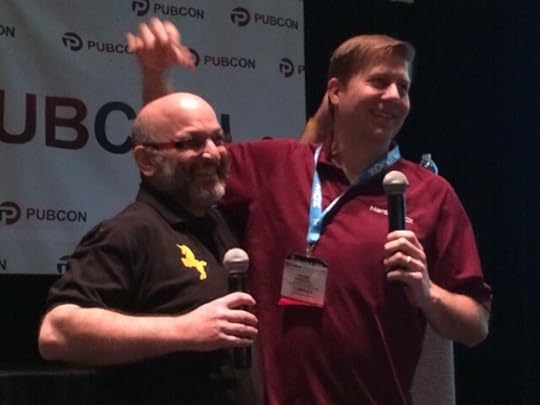
“Treat the C-level the same as you would an 8 year old: pretty pictures and simple numbers.” — Alan K’Necht. The C-suite is like kids in that they talk in TLAs (three letter acronyms). But don’t use your SEO acronyms or jargon.
What do you report? Short term: volume, mood, PR successes and problems; long term: social’s impact over sales, which are not easily attributable.
So draw them a treasure map with little milestones that have to happen along the way. Then report that progress toward that long-term goal of getting the treasure ($).
Always tie what you report back to a company goal. What’s public? What’s semi public? How is the C-level measured?
Q4: What is the measurement/signal that brands forget to think about?
These get to the impact on retail / social awareness at a retail level.
Branded keyword queries

Direct site traffic
Q5: What are some useful and reliable tools for measurement?
Listen twice and then think. First ask yourself, “What am I trying to learn?” and “How will this tool help my business?” Also ask:
Where do you need to go with it?
How fast do you need to get there?
Do you care about how it looks?
There’s nothing wrong with the top tier tools (radian6, Lithium Labs, meltwater buzz). But before you think about the big tools, what are you doing with what you have? (MacGyver could stop a train with gum and a paper clip.) Basic tools are:
Facebook Insights (Analytics)
YouTube Analytics (which provides segmented stats, video interactions and source data)
Pinterest.com/source/URL (Pinterest Source)
Foursquare and Facebook check-ins
Share counts (and look at them in context — you might have fewer tweets but more LinkedIn shares and it reflects that the content was geared toward executives)
Twitter Apps (Tweetdeck, Hootsuite, Crowdboaster)
Social Mention
Tweriod, Followerwonk (which time of day and day of week is it best to publish something)
Q6: How can you use social to influence search?
How do you get your brand or phrase to show up the Google Instant suggestions?
Search is highly dependent on one overriding component, which is INTENT. Search requires some level of awareness. You can’t search for something you don’t know. Look at a Google Trend of “pre-owned” related to cars. Toyota stayed steadfast in establishing the use of that term even though it lost them a lot of traffic for a while. Today all the car manufacturers use “pre-owned” language.
Food for thought: if no one else cares about your stuff, then don’t expect the search engines to either. Understand causation vs. correlation. Just because there’s an umbrella out doesn’t mean it’s raining.
Q7: Example of a big brand doing it right?
Zicam built loyalty. CVS lost the opportunity.
Q8: Example of a small brand doing it right?
A BBQ joint in Alan’s neighborhood decided to just focus on Facebook and are doing it right. They admit mistakes when they’re made. They create incentives for people to follow them on Facebook. They don’t spread themselves too thin by using a bunch of different social networks.
Caribou coffee did a Pinterest promotion that was going to help them come up with a new blend inspiration via crowd sourcing.
Q9: How do I tie sales and revenue back to social activity?
Or, how do you value a cocktail party?
Sales/revenue: low instant gratification signals (usually)
Customer service: high instant gratification signals
Q10: Why can’t I use junior interns to manage my social media?
They might have 5k friends on Facebook. But they haven’t used it for business marketing, promoting others or customer service. They lack a business sense.
Bonus final thought: One enthusiastic unpaid brand advocate is worth more than 1 million unengaged followers who never see your posts.
Bonus final thought 2: Social analytics is ultimately actionable data.
Bonus final thought 3: Don’t wait for the dashboard to take action — you may be too late. Dashboards summarize the success of the actions you’ve taken.
#Pubcon Liveblog: SEO Moshpit — Q&A with the SEO “Old School”
#Pubcon Liveblog: SEO Moshpit — Q&A with the SEO “Old School” was originally published on BruceClay.com, home of expert search engine optimization tips.
What follows may be one of the most interesting conversations that took place on SEO in New Orleans this week.
This assembly of online marketers has 150 combined years of experience in SEO, Brett Tabke, head of Pubcon, estimates.
William Leake (@Marketing_Bill)– CEO of Apogee Results
Bruce Clay (@BruceClayInc) — President of Bruce Clay, Inc.
Tony Wright (@tonynwright)– CEO of WrightIMC
Rob Garner (@robgarner) — Chief Strategy Officer of Advice Interactive
Stoney deGeyter (@StoneyD) — President of Pole Position Marketing
Greg Boser (@GregBoser) — President of Foundation Digital
Joe Laratro (@jlaratro) – President of Tandem Interactive
Question 1 (Brett Tabke): Google has been taking proactive steps against SEO the last year; not provided means referrals are dead and we don’t know where traffic is coming from anymore. How are you coping with what are the most dramatic changes to SEO in the last 10 years.
Bill: They’ve on shored a lot of jobs back to North America. YOu need to have someone writing, optimizing and promoting content that is part of the culture. This has dramatically increased the cost of content and SEO and made content marketing much more integrated into SEO.
Bruce: Everyone has had to figure out that we’re in the traffic business and not ranking or attribution. It’s not clear if Google is going to continue to provide keywords for PPC. There’s agreement we’re going to be doing more content work.
Tony: The biggest thing about this industry is most of us are mavericks and we work in this industry because we didn’t fit in other industries, and so we adapt. What we’re seeing in the industry is a shakeout and some are getting left behind. Tony says this has been good for him because he comes from a PR background. He hires writers; people who are good at making something someone wants to read. He says it’s more about the message than the method anymore.
Rob: Google can keep doing what they’re doing because it only gets the bad players out who can’t fake it and that helps the industry. SEO may come to live under different names like digital asset optimization. He’s going back to what you can control, like how you’re pages are laid out from a linguistic content perspective and if you lay out your structure so that you can see sales tied to traffic from the organic channel you know what topics and keywords are important to your business.
Stoney: Our job is getting attention and Google is an avenue but they don’t dictate how we get that attention. They can penalize guest blog sites but they can’t penalize guest blogging. Besides, quality of content and what we’re doing with content and how we promote ourselves is always what we should be focusing on.
Greg: If what happened with Google is about quality control, then those sites wouldn’t have any impact on the algo. But instead they had an infiltrated spy job. The lesson of the MyBlogGuest penalty is that you can’t pull together groups of people, you have to be out on your own. SEOs have always been the cockroaches of the Internet and we adapt and survive. Deep content strategy and content performance analysis has long been the most important thing for good SEOs.
Joe: I don’t like the terror marketing that this is causing. Marketing companies are spreading misinformation that’s able to gain traction because of the fear.
Question 2 (from Brett): One of the themes of the conference has been, now that keyword referral data is gone, rankings are again in vogue. Have you found that?
Greg: I don’t think rankings ever went out of vogue. It’s not an either-or thing. You can’t say that because I care about rankings I don’t care about conversions. You have to have an idea of how your content is being displayed. You need an idea at the page-level analysis because then you can narrow it down based on phrase popularity and where they’re ranking what it is that is attracting viewers to that content.
Bill: I don’t think we can get away from rankings completely. Rankings are one of the few things we can provide when the client has analytics set up incorrectly. And rankings reflect how branding is affecting things. If you’re not visible on branding and visibility keywords, we’re not building a brand. We have to talk about concepts like brand, not just direct response and sales.
Tony: I care about control of voice. I want mentions on my SERP. There is a mini branding effect on a SERP. If a user is querying multiple keywords and they keep seeing your name, you create a perception of prominence in that field. You’ve just become the leader in their perception. There’s client perception and agency perception. A client thinks ranking is ego more than conversion — they have to be number one because they feel they’re the best. At an agency we recognize rankings more as an indicator because rankings are relative. And from a deliverables standpoint, rankings show that you actually did something.
Bruce: Ranking is important to anybody with a reputation management problem. When we look at ranking we back up to a paid API from Google — it’s raw data from the index without any personalization. What it allows me to do is make a change to the page and let me see if it makes a difference. This is the only way to make a difference in an apples-to-apples way.
Stoney: He tells his clients if your business grows without getting a single top ranking then we’ve done our job. A good example of where rankings don’t matter so much is a client that they got a top ranking for and the client was happy. After an architecture change they lost the pet keyword but they got a lot more pages on the site ranking and created a big lift in sales overall.
Question 3 (from audience): Do you see a trend or a social coups of websites blocking Google from crawling as a response to Google scraping and cutting sites out of the equation?
Greg: Google is cannibalizing industry after industry and Knowledge Graph is a click black hole and making it even worse. That’s why he focuses on audience building and creating direct connections to your clients. You need people to direct navigate to you, RSS subscribes, newsletter signups or capturing email so you can market to them later.
Rob: Will more sites start blocking their content? Most businesses have an economic dependency on organic traffic, from 5-50% of revenue. So while they won’t cut the cord, there’s huge pent up frustration.
Tony: He has no faith in the general public changing their behavior of not going to Google. The only thing that might work is government intervention a la Ma Bell split into Baby Bells. The DOJ is already looking at it.
Rob: When we start to regulate Google to not crawl the open Internet, that’s a huge problem as a matter of policy. He thinks net neutrality and open Internet is a big issue right now.
Greg: We held Google to the goal of connecting us to the world’s info. But Google baited and switched and now they want to own the world’s info. We have to hold Google to not delivering all their own products. The only third-party aggregate that Google wants in the world is Google.
Bruce: Are we in any position to legislate that Google will remain a hub and not an authority? Google doesn’t make money from organic, even though they have to have it, but the less they can get away with they will.
Bill: If Google becomes the trusted brand. Remember you’re not Google’s customer, you’re Google’s dairy cow. What’s the least we have to give you so you keep coming back, Google treats advertisers. If you don’t conform to their terms, that’s a long term danger for any content publisher out there. Google learned from Microsoft and they own more politicians than anyone but maybe Oracle.
Stoney: Google has done such a masterful job of making us dependent on them. He loves Gmail and Google Docs, and we don’t want Google to be the monopoly but it’s too convenient and we love it. When do we say that’s enough, I’m getting off the drug?
Brett: Almost 85% of the traffic to Microsoft is from Google. For the most part his business ignores Google and focuses on social.
Bill: Publishers are putting a lot of content behind paywalls and it may be working so maybe it’s time to say do not index our deep content and allow indexing of just our top pages.
Question 4 (from Brett): Where is SEO going in the near future, the next 12 months? Do we keep feeding into Google, with more products like Google+?
Bruce: For background, understand that Google has stated that KG is just another tool in the Swiss Army Knife that makes their experience more useful. So understand that as we at the same time, as marketers, feel it from a different perspective as a loss of traffic and visibility.
Bill: Google believes that. They can say, look what we do for you with 85% of the traffic. Imagine what we can do with 99%! Now for ecommerce, keep in mind that Google is cuddly next to Amazon.
Tony: Back to “where are we going?” he has faith that if he builds great content they will come. He hates digital sharecropping, which is essentially building on Google’s land. He works to build value on his own property or no one will visit.
Greg: The next step is leveraging what other people are doing, and apps are a great place. He finds more of the searching he does personally is on apps and vehicles pushed straight to his phone.
Joe: Why is Google penalizing guest blogging so aggressively? That’s a sign that social search is where they want to make progress over the next 12 months.
Bruce: There’s going to be a period of time that sites that answer the how question will be doing well, as it avoids dependence on the delivery of simple facts that Google has subverted with Knowledge Graph.
Brett changes the topic to MyBlogGuest.
Brett: Yesterday’s announcement that Google penalized the guest blog network run by well-known SEO writer Ann Smarty sent major waves through the community. It was first hinted at by Matt Cutts at SMX West last week.
Greg: If they had never mentioned the word “links” in the promotion of it, they would have been safe from Google. And it’s sad you can’t be honest about that benefit. He also points out that there are much lower quality guest blog networks and that for what it did, Ann’s network did it best.
Rob: Guest blogging and posting being an illicit tactic is ridiculous. Is Woody Allen’s guest editorial on the New York Times spam? Of course not. And there’s a lot of meaningful discourse that occurs from guest contributions. When you are public shaming to a small audience, most of the world doesn’t see this, it’s clear it’s a ridiculous tactic that’s trying to overcompensate for a weakness in the algortithm. He’s seen the quality of search results going down in the last year. Now that content marketing has become in vogue with marketers and as the web expands he thinks Google is finding it harder to sort through the quality. They’re needing to scale to the quantity of content that’s coming out.
Tony: Yesterday’s actions are more disturbing than any penalties he’s seen because there’s value in guest blogging. It comes back to economic value and businesses afraid of getting on Google’s bad side can be hesitant to participate in a very legitimate marketing practice.
Bill: They’ve slammed sites that are entirely guest sites so your site having mixed in a little bit of guests with a broader stew, you’re probably still okay.
Bruce: There’s a common theme. When Google started penalizing links it was looking for sites to commit to a theme. And he suspects that the guest blogging that’s penalized are examples of writers that are not focused in their content topics. We’re seeing networks penalized when there’s no topical focus.
Greg: You see this in the disappearance of Authorship photos as well. The topical focus of a site, of your body of work as an author, those are going to be considered in author authority and whether or not Authorship is displayed in a SERP.
#Pubcon Liveblog: Tim Ash Keynote — The 4 Pillars of Trust
#Pubcon Liveblog: Tim Ash Keynote — The 4 Pillars of Trust was originally published on BruceClay.com, home of expert search engine optimization tips.
Tim Ash studied computer engineering and cognitive science — this gives him a unique preparation for Internet marketing that’s both quantifiable and not; art and science.
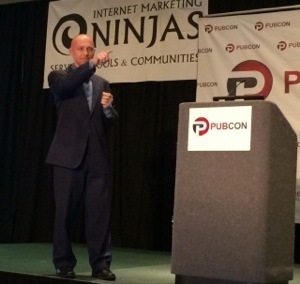
Everyone has about 100 billion neurons in their brain. And it’s only now that we’re opening up new frontiers of the brain with real-time brain imaging and sophisticated analysis to find out how people respond to marketing inputs.
He’s rereading “Thinking Fast and Thinking Slow,” written by a psychologist who won a Nobel Prize in economics. Who’s heard the premise that what makes us different from other animals is rationality and consciousness? But 95% of our thinking is unconscious. You have two systems: the gut, intuition and logic — it’s a crude oversimplification but it’s generally true.
It’s not about the technology. It’s not 140 characters or real-time tech — it’s about trust.
The 4 Pillars of Building Trust Online
This isn’t just theory, it’s about things we can do as marketers. His company SiteTuners is one of the premiere conversion optimization firms in the world.
Trust in the real world is given in concentric circles. The difference between an acquaintance and a friend? A friend will help you move. The difference between a friend and a close friend? A close friend will help you move … a body.
You have circles of those closest to you, followed by people who are friends, people you know, etc. Have you noticed how big city people are mean? Trust is diffused the more you’re surrounded by strangers. And yet you still extend trust to total strangers because otherwise society would break down. You expect strangers won’t slam doors on you and will follow traffic rules.
So what about trust online? How does it differ from trust in the real world. As marketers, in order to get someone to buy something from us, don’t they first have to trust us? It’s different online in 2 ways..
Trust must be gained instantly online. You have 50 milliseconds (one-twentieth of a second). Over half of your brain is dedicated to processing visual information. We figure out in an instant where a website lies on a continuum from cheesy to professional.
Trust must be given anonymously. What do we know about our visitors? Referral source. Location via reverse IP lookup. Device type. Operating system. Browser resolution. Does that help you sell to them? To the device, yes. A user on a mobile device is under time pressure, not considerate or in deep thought.
Who’s site is on responsive design? (Nearly all the hands go up.) Who’s actually thought about how the delivery of content might differ for users on mobile devices? (The hands go down.) He says that changing the column width isn’t designing for mobile — it’s ADA compliance. It’s a wheelchair ramp.
The truth is you don’t know anything about them. They don’t know anything about you. The latter is all you can control. So address these 4 pillars.
1. Appearance
There’s a part of our brain that is there just to recognize faces and works twice as fast as our other visual recognition brain components.
Would you buy a grand piano from this website?
This company is the number one piano sales and repair company in the DC-Baltimore area. But their website is cheesy and the website doesn’t convey trust.
If you’re involved in the visual components of website design, you’re interested in art and enjoy making art. You’re frustrated artists and so you “decorate the site.” If you’re managing this type of artist designer, keep them on a short leash. When you’re at work, stay inside the box. The box is the bank box that your business puts it’s money in. You have to ask “Does this graphic support our call to action directly?”
Don’t get disqualified based solely on how you look.
Professionalism of design
Sparseness and neatness
Organization and clarity
2. Transactional Assurances
You’ve seen the BBB and VeriSign and other logos on a site that communicates a trust signal. But if they’re along the bottom of the page, very few people will ever see it.
Above is a strong placement of the trust badge, placed where the convention is to have the brand logo.
Also strong to present these trust badges at the moment of purchase. A BuySafe and VeriSign Trusted badge next to the “Add to Cart” button can relieve uncertainty.
Relieve point-of-action anxieties before they arise.
Forms of payment and delivery
Data security and privacy
Policies and guarantees
3. Authority
We naturally are pack animals and respect hierarchy. The RealAge Test added logos of media mentions under “As seen on” and got 40% more completions of their test. The recognized logos transferred trust.
In B2B if you have a form you want people to complete, use marquee client logos on the page. You eliminate the question of whether or not their qualified to do the job. In this example they saw 58% more form completions:
You don’t even have to recognize the logos for it to work. He calls it a butterfly collection — they simply look cool and an impressive and it led to 52% more conversions.
Borrow trust from better known brands.
Reviews and awards
Marquee clients
Media mentions
4. Social Proof
We care about what our peer group thinks about things more than what our moms think, or what people not like us think. Seeing a friend’s picture show up on a page because you’re signed into Facebook increases conversions by double digits.
Support automatic compliance by demonstrating social proof.
Objective large numbers
People like you
If you want to drink from the firehose of conversion marketing and optimization, attend the Conversion Conference in Chicago in June. Registered by April 1 with the code ALUM2014 and get your ticket for just $697.
March 19, 2014
#Pubcon Liveblog: SEO Beyond the Filter Bubble
#Pubcon Liveblog: SEO Beyond the Filter Bubble was originally published on BruceClay.com, home of expert search engine optimization tips.
Strategic Considerations for Getting Past Google’s Personalized Results
Chris Boggs @boggles, Internet Marketing Ninjas
What Is the Filter Bubble? The filter bubble is users getting less exposure to conflicting view points to where they become isolated intellectually in their own information bubble. Eli Pariser an Internet activist defined it this way. Some people feel the filter bubble is negative because of potential manipulation of the kind of info a user may see. We can’t know what we’re missing because of the filter bubble. But we’re agreeing to that when we use Google who is in their own mind returning the best set of results to us.
Disclaimer: Content is still king. Google isn’t always going to get it right or have the inventory to deliver a result the user wants.
There are some areas we can reinvent how we’re looking at SEO that optimizes for the filter bubble.
1. Brand Search Implications
How do I get to the scoring layer? You need a functional modern search engine to open up its algos, i.e., you need a Google simulator (without all the personalization/query layer). Ask him about the Google simulator he’s built and using and seeing 50% higher ROI on SEO.
#Pubcon Liveblog: Google+ and Authorship Hot Topics and Trends
#Pubcon Liveblog: Google+ and Authorship Hot Topics and Trends was originally published on BruceClay.com, home of expert search engine optimization tips.
Common Characteristics of Full Authorship Results in SERPs
Mark Traphagen @marktraphagen, Stone Temple Consulting
In the second week of December there were an increasing number of reports that author photos weren’t showing up as often in SERPs. At Pubcon Las Vegas last year Matt Cutts said that when they reduced the number of authorship results shown in SERPs by 15% they saw better results. Take that to mean whatever Google speak you think it means. Here’s the initial drop followed by continued periods of volatility.
The first time might have been that Google found they cut a little too deeply which is pretty typical.
Another major change you saw happen at that time is more second-class authorship results — just a byline and not the author photo.
Mark attempted to identify commonalities of what happened when authors got more, fewer or the same amount of full authorship results.
The classifications of his findings:
No Change
Mixed by Site: for some sites the author sees full authorship and others see no byline or second-class authorship
Mixed by Content: Some content on a site shows a full authorship result and others only see a byline
Mixed by Authors: One site shows full authorship for some authors and reduced authorship for other authors
Author Loss Across All Sites: The author saw reduced authorship results across all the sites they contribute to
Reduction by Query: There was an algorithmic change that adjusted which queries deserve authorship results.
Messages from the Kidnappers
An anonymous Google source told Jenn Slegg who reported on Search Engine Watch: “estimating quality of an author’s documents,” “the documents an author typically writes”
Authorship is a qualifier in the case of in-depth articles — a threshold you have to cross to get into a Google feature.
So now the patterns he identified in his analysis. Keep in mind there are exceptions to each.
Authors that kept their full authorship results had these qualities.
Factor 1: Author Reputation
Reputation for quality content
History of publishing such content
Consistent earning of social shares
Factor 2: Site Quality and Reputation
High domain authority
Long history
Never been penalized
Frequently publish quality content
If a site had authorship site-wide or was including authorship on content that isn’t considered “authored,” the authorship was dropped.
Recovering the Kidnap Victims
Publish on high-quality, trusted sites
Quality over quantity (but stay fresh)
Connect rel=author only to real content
Google Authorship: Search Snippets
Ann Smarty @seosmarty, Internet Marketing Ninjas
is doing an overview with some looking at the future.
The obvious advantage: Authorship photos attract more clicks.
The history: Authorship snippets started to appear in June 2011. That same month, Google+ was introduced and Google profiles redirected to Google+. Google+ became the center of the Authorship program. In October 2011 the author photo moved to the left and counts were added. In 2012 there was some simplification and “more by” the same author was added. In April 2013 “more by” is removed.
Today you don’t always see the number of circles an author is in. You’ll also see that if the same author has 2 results, the second result won’t have a photo.
Authorship + Rich Markup
Authorship is combined with other rich snippets as well. You may see a video thumbnail on a listing where the author’s name is included. You may not see an author photo if reviews rich snippets are on the result.
Authorship Outside Web Search
Google News is the first place Authorship results were displayed.
Google Images has also added Authorship but it associates it with the article that includes the image (not popular with photographers).
In the Future
Help identify a spammer
In the future we might expect Author Rank too
Authorship, Rank, Identity and What’s Next
Kristine Schachinger @schachin, SitesWithoutWalls.com
Where did Authorship come from? Do you think of it as an SEO tag? Or a way Google ranks things? She suggests it’s actually about establishing identity.
People usually talk about the Agent Rank patent when talking about Google Authorship. This simple patent speaks to credibility, potential ranking system and digital signature.
Eric Schmidt has revealed that Google+ is not a social network but an identity network. It’s about identifying people, authors online. The White House announced a National ID System in 2011.
ID providers remove the need for passwords. What does this have to do with SEO?
Authorship is one of the first identity tags implemented online. It’s about knowing who you are, who you’ve published with, who you write for, your actual identity. Schmidt said that verified profiles will be ranked and the cost of anonymity may be irrelevance.
Patent: Authentication of a Contributor of Online Content. You see “credibility factors” and “authentication score” detailed and this is a patent at play for Authorship that is less frequently referenced publicly.
What’s next? Google is looking for topic experts, authors that are experts in a topic. The goals are to get rid of spam and provide more relevant info. They do this by knowing who you are, by having authenticated authors, by verifying who you are through identity factors, to authenticate your author profile online and by asserting your author/post credibility.
#Pubcon Liveblog: Conversion Web Design
#Pubcon Liveblog: Conversion Web Design was originally published on BruceClay.com, home of expert search engine optimization tips.
Presenter Kim Krause Berg @kim_cre8pc, Internet Marketing Ninjas, will talk about how to get your ducks in a row before you start building your site and always include conversion elements in your design.
Conversions are turning visits into sales. You think conversions are making money, getting subscriptions, increasing form submissions, increasing sales leads.
Your target users think conversions are …
Do you have what I need?
Are you genuine, credible?
Do you provide excellent customer service?
Prices?
Opt-in/opt-out signup
Are they spying on me?
Will I be able to read it?
Can I access the site from my phone?
Can I get in and out in a hurry?
Persuasive conversions design is purposeful website design. With usability you’ll find there’s a lot of “abilities” not being met. You’ll see confusability, such as competing sign up/sign in links. If you want to increase conversions, remove blockages and distractions. Meet user expectations in navigation and links. She shows the Forever21 navigation with links that say 21 St. and Love 21 — it’s not clear to the user what those are.
Customer service is a simple area to improve conversions. Make it clear what is supposed to be clicked, or why they should click via triggers and call to action.
Search Engines and Social
Search = Findability = Usability = Increased Conversions.
It matters to you because it affects search engine rank, PR scores, landing pages that convert, authority and brand reputataion.
Make your “follow me” social call to action count. Add your social networks to your site and provide a reason for visitors to follow.
#1 tactic: provide answer at the point of the question.
Before sliders, add introductory text and a heading
Add action words to nav link labels
Make calls to action obvious
Avoid gray text
Test for color contrasts — see tool joedolson.com/tools/color-contrast-co...
Use common terms
Remove distractions
Provide proof
Common designs that decrease conversions:
Mystery links
Unidentified links
Readability
Understandability
Navigation/poor IA
Functional errors
Credibility
No page consistency
Rendering on various devices
Load time
Ads
Moving images
Calls to action below fold
Free Mobile Eumulator: http://mite.keynote.com — you can view your site as seen on a variety of devices.
To communicate a sense of place:
Choose keywords for content headings
Research taxonomies. what terms do your target visitors use?
Breadcrumb navigation
Scrolling — easy to hide call to action
Information Architecture Tools: IA and conversions are closely tied. Build your site so your sales funnels are built in and people can flow along. Look at tools Mock Flow, Balsamiq and Slickplan.
Check out her free ebook “The Secret to Natural Website Conversions.”
Karen Thackston is Kim’s choice for lessons about marketing writing for conversions.
#Pubcon Liveblog: Local Search Hot Topics and Trends
#Pubcon Liveblog: Local Search Hot Topics and Trends was originally published on BruceClay.com, home of expert search engine optimization tips.
Local Search Strategy: Barnacle SEO
Will Scott @w2scott, Search Influence
Google sucks. Google treats small businesses as a rounding error in their economic equation. A strategy for local businesses is barnacle SEO: attaching oneself to a large fixed object and waiting for customers to float by in the current. Google says the most important thing in business is sincerity. If you can fake that, you’ve got it made.
Google has a weakness; they’re a sucker for big “authority” sites:
YouTube
Yelp
Houzz
YP.com
Google, in the last several months, has unbundled results from the same domain. Previously you’d find

Here we see yellowpages.com listed 4 times.
What?
So now he’ll show some ways we can figure out what results Google is going to show and try to latch onto that opportunity.
Query “gastric bypass surgery new hartford ny” — gastric bypass is a very competitive term and when you do this search you’ll see Dr. Graber coming up 9 times on different domains. He’s winning that very competitive SERP.
Query “bounce like beyonce” — you’ll see a plastic surgeon at the top of the page from their YouTube video.
How?
Video is the strongest inset in Universal results and YouTube is 8/10 of those video results. Local is back to being long-tail search. Hang your local search phrases off an authoritative site, like YouTube.
Check out ranking reports for your local keyword phrase.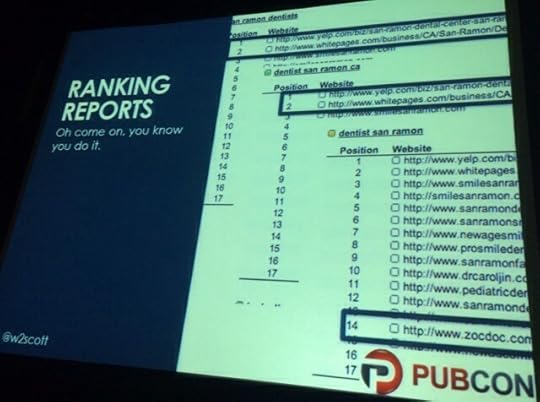
Think of other sites where you might be able to position your content and how you can make that work for you. Adding some links to the Zocdoc result in this ranking report may be able to get it into position 3 or 4 from 14.
Local Search: It’s No Laughing Matter (Or, the Factors of Local Search)
Greg Gifford @greggifford, AutoRevo
Greg’s presentation can be viewed here: http://bit.ly/localsearchcomedy. He works at an SEO and social media firm that services car dealerships.
There was a huge algo shift from October through November 2013 and saw a return to an old way. The map pack stabilized to 7 listings. There are more search results in the search results. Optimized vertical and local directories are ranking well now where they hadn’t been before the end of last year. Now you can get several results on a SERP (organic plus map-pack). There’s a huge opportunity by simply adding city and state to a web page Title tag.
2013 local search ranking factors: these influence rankings
Google+ Local (aka Google Places, Google for Business and every name they change it to)
Google wants Google+ Local to be like a drive-through — get in and out quick with what you need. If you are having issues you can get help in the Google Business Forums (but he says this with a sarcastic flair, as though getting Google to help you might be possible but is unlikely).
They are finally merging Google’s old Places dashboard and the new Google+ Local dashboard. If you previously forced a merge, you’ll be getting an email warning you about “duplicate listings.”
Optimization tips for Google+ Local business page:
Write long, awesome descriptions and use formatting and links
Upload lots of photos
New update: you can now add a single descriptor to business name (to help locate or describe) — it’s going to get spammed but hey, why not try it since it’s a new rule Google’s allowing
You can now add up to 10 categories
There aren’t many users on Google+ but do your best to engage
Circle users as your business
Reviews
Reviews are back to stars, but now with decimals. (Zagat rating system is gone.) Reviews now appear in an isolated pop-up. Know that you can’t buy a good reputation, you have to earn it. No strategy will help you get positive reviews if you’re not good at what you do and good to customers.
Tips for getting reviews:
Remove roadblocks
Ask for reviews and tell them how (but not for Yelp)
Don’t ignore Yelp — it powers Apple Maps
You need 5 reviews to see stars on Google+
Shoot for 10 reviews on Google+, then diversify to other third-party review sites
Only you can get reviews — you have to ask
Tactic: handout with instructions (cheap printed 4×6 card)
Tactic: follow up with emails but don’t do it in an automated way because you don’t want to ask for a review from someone who left you one
Slow is okay — most businesses get 1-2 a month
Don’t copy reviews to your site; Google wants Google+ reviews to be unique so they’ll remove duplicates from their property
On-Site Optimization for Local
Landing page optimization tips (but really, should be every page):
city/state in Title tag
city/state in H1 heading
city/state in URL
city/state in ALT attributes (don’t forget photos on your landing page)
city/state in Meta Description
city/state in content
Embedded Google Map pointing to G+ location, not just address
NAP on landing page must match NAP on G+ page
Use schema markup in your NAP
Include NAP on every page
You must use a local number — no call tracking or 800 numbers Would you rather have tons of data that you don’t use or get more phone calls?
Create awesome content for local:
It’s all about branding.
Make your blog a local destination.
Blog about your community.
Sponsor local events.
Create local event guides.
Review local businesses.
Create a local resource directory.
Interview local figures.
Crazy idea: do just a little linkbuilding and social on your local content.
What if you’re not in the area that you’re trying to rank in? An example is a rehab center. “The best rehab facility in California … is actually in Texas.”
Links: You don’t need that many to succeed in local, but don’t ignore low domain authority local sites.
Citations: Are you almost in the map pack or almost #1? More citations (mentions of your NAP on other websites) will get you over the hump. Structured citations are directory listings. Unstructured citations are mentions like in a blog. Look up tier 1 and tier 2 citations.
The tool he uses for citation management and research is Whitespark. It spits out citation ideas and checks current citations by running your phone number and you can get ideas by running your competitor’s phone number. Then compare yourself to your competitors.
The number of businesses in the carousel depends on the user’s resolution, dimensions.
Usually the photo that shows up is the first photo uploaded to your Google+ account. Google’s solution to this problem? Delete all your photos and start over… But that doesn’t work if you didn’t upload the first photo. So, over the last few, months Google has been changing photos and is shifting from exterior shots until, lately, it’s been interior shots. Learn how Carousel thumbnails are cropped for display: bit.ly/carouselcropping. There might be an answer coming about how businesses can choose their photo.
Local SEO Tools
Moz.com: Good at a little bit of everything. Open Site Explorer is a must.
Places Scout: Local extravaganza! keywords, ranking, reputation management (archives and reports new reviews)
SEMrush: Primarily for PPC intel and keyword research with a new rank tracker
Link Prospector: Tool for discovering link opportunities
CopyPress: Content creation outsourcing at $50 for 500 word article, including ideation
Followerwonk: Twitter analysis
ReTargeter: Display ad remarketing
WordPress Tools
Yoast SEO is vital but turn off the OpenGraph Meta info in Yoast. He doesn’t get it right. You don’t want it to pull a random image and use the same SEO Meta data.
Open Graph Metabox: set unique OG dat per post/page
nRelate Flyout: showcases similar content; increases engagement/time on site
WordFence Security: best security plugin available and it’s free
#Pubcon Liveblog: Peter Shankman’s 4 Rules of Customer Service and Social Media
#Pubcon Liveblog: Peter Shankman’s 4 Rules of Customer Service and Social Media was originally published on BruceClay.com, home of expert search engine optimization tips.
Peter Shankman @petershankman invented a mailing list called HARO. And that wasn’t new. People knew what a mailing list was when he started it. The only difference was that he made it really hard to not read it. When he was building HARO, he came up with four rules for running his business.
$300 billion was left on the table last year due to bad customer service. Consumers don’t expect to be treated well. If you can be one level above crap, you’ll win. Following these four rules will cause you to provide good customer service.
First, some background on him. Peter was in grad school in Santa Barbara studying fashion photography until his financial aid dried up and he moved into his parents’ basement in New York. He was hanging out in the Melrose Place chatroom on AOL. Two weeks later he was working in the newly launched AOL newsroom. While working there he learned two lessons:
Lesson 1. At the time the Internet wasn’t free. It cost you $2.95 an hour if you could connect to a modem. His job at AOL was basic: keep users online as long as possible, because that’s how we made money. Our job is still to generate revenue, but we’ve kind of forgotten because we’re caught up in followers and fans. Followers and fans don’t keep the lights on. Until we realize it’s about revenue and always has been, we’re screwing ourselves.
Lesson 2. Your biggest threat isn’t AOL vs. MSNBC trying to get a hold of a million users. Your biggest threat is Seinfeld — 100 million users who aren’t online yet. You can’t grow if you’re worrying about fighting off a possible competitor. You should be worrying about the customer who hasn’t heard of you yet and getting them. Facebook isn’t about getting you on to Facebook, it’s about getting you to where everyone else is.
With that background set, let’s get to the 4 rules. The 4 rules are simple, and you learned them as a kid.
Rule 1: Transparency
President Obama won the office on the platform of being transparent. He made his first appointment in Tom Daschle, and Daschle stepped down because of a nannygate issue. He had an interview on national TV the next day and the reporter confronted the issue. Pres. Obama admitted a screw up, and the whole issue was diffused. The next question posed was, “What kind of puppy are you going to get?”
If you own a mistake, you’re 44% more likely to stay in good favor with your audience than if you deny and get caught.
The big mistakes in social and customer service come from lying, denying and fighting with customers. At HARO, Peter found that if he talked about an issue before anyone else did, there was never a problem. If he was reacting to someone else making a claim first, he was playing catch-up and it was tougher to rebound.
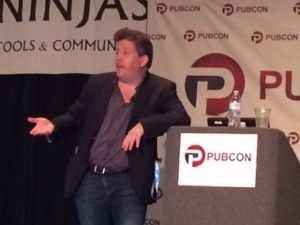
Rule 2: Relevance
In the ’50s, the average age of nightly news viewers was 31. They got the newspaper in the morning delivered by Timmy, and they got the news at night on TV. The average age of the nightly news viewer today is “dead.” Today, instead, you come home and charge your phone, removing it from your person for the first time that day. You turn on the TV, walk away, come back and see that nothing’s blown up, change the channel to Comedy Central, check your phone again and go to bed. We are an audience of fractured attention.
How do you learn how your audience likes to get their information? Ask them. It’s easier than ever. He would email five random HARO email list recipients and ask them how are we doing. When you interact with your audience and give them what they want, they become invested. An invested audience is 78% more likely to buy something from you or otherwise give you money.
Peter donated to an animal nonprofit and got a hardcover coffee book from the organization. He called and asked why they did that, and the answer was they believed they had an older audience that liked print material. He joined the board of advisors and had them survey their donors; 94% said they preferred to get information online. The group got active in social media and created thank you videos for donors. Donations went up 37% in 12 months. They saved $500k in printing, mailing and reproduction.
Rule 3: Brevity
The attention span of people between 18 and 25 years old is 2.7 seconds. If you have 2.7 seconds to reach your audience, the best thing you can do is learn to write. Ninety percent of interactions online start with print. Half the sites on the Internet have a spelling or grammar error on the home page. Bad writing is killing America. Good writing uses brevity.
140 characters is roughly 2.7 seconds, but before you get caught up on Twitter, realize that mobile is the future and Twitter is just one pipe. Understand the difference is concept vs. brand. The concept is mobile, the brand is Twitter.
Rule 4: Top of Mind
Barry Diller is CEO of InterActiveCorp. When he took the helm, he got into the office an hour early and would call in 10 random people from the company a day. He reached out to other people and said hi. The company turned around. Remember his earlier claim that likes and followers are bull—? Mark his words. In 10 months the concept of following, friending and liking will be gone. Instead it will all be determined by your actions in the real world. Have you ever asked someone if they’ll be your friend? The concept is unnatural.
You text someone, inviting them to hang out. Online you socially check in together somewhere. You make another date and make a reservation on OpenTable. The network sees the accumulation of positive interactions and touch-points. If you get into a disagreement and aren’t friends anymore, you don’t need to unfriend someone — you just stop talking.
Every business and person you have an interaction with is like a bubble in a lava lamp. Heat is the accelerant and energy. If you don’t have trusted interactions, your bubble floats to the bottom and doesn’t resurface. That’s what algorithms are trying to create.
PR will become personal recommendation, and you’re going to get the customers you want by being awesome to the customers you have.
Peter was flying home from a trip to Florida. He sent out a tweet to @Mortons Steakhouse and jokingly asked for a porterhouse to be waiting for him at the airport. Morton’s did it, and Peter Shankman wrote a blog post titled “The Greatest Customer Service Story Ever Told.” The CEO of Morton’s was on the Today Show the next day. Revenue doubled over the next year. That’s not scalable and you don’t have to do it for every customer. But when you ask your customer if they’re there for a special reason today and then show them you paid attention, they’ll tweet it and be loyal brand advocates.
March 18, 2014
#Pubcon Liveblog: Creating and Selling Awesome Content in Boring Niches
#Pubcon Liveblog: Creating and Selling Awesome Content in Boring Niches was originally published on BruceClay.com, home of expert search engine optimization tips.
Do you think your business is “boring”? Do you struggle with creating content that matters? The next presentations are for you.
Creating Content for Boring Industries
Kelly Ament @kellyament, Get Noticed Get Found
First, let’s dispel a common myth. There’s no such thing as a boring industry. Every industry exists to fill a need, to do necessary things, for people who care about getting the best service.
There is, however, boring content. This includes content that is not useful, doesn’t speak to target audience, or isn’t interesting or entertaining. Good content furthers your strategy and goals.
Writing Words of Wisdom
Answer questions. If you’re the business or brand that’s answering questions honestly and sincerely, that establishes you as a trustworthy brand.
Get inspiration from others. The best writers are the best readers. See what works for others on a variety of mediums. You can repurpose/curate content.
Get creative. You don’t have to stick with safe subject matter. Look for new spins to put on old issues. Make your delivery unexpected and interesting.
Write for people; optimize for search engines. The ultimate goal is converting the prospect into a buyer. Create content people will share, enjoy, persuade them to connect with the brand. Then go back and optimize for search engines.
Selling Guns 2 Gandhi: Getting Content Buy-In
Steve Floyd @nawlready, AXZM
You came up with a fantastic content strategy but then it gets shelved. Here are things he’s done to help him get wins. You can’t expect a content type to fit every business. The future of search is very creative. You have to stand out to your customer in everything you do by way of content.
If you want to get buy-in you have to keep it simple.
The key is balance. Give stakeholders the info they need to know now and hold back the things you don’t need to give them up front, things you can drip as needed and when the time is right. Condense and centralize documents. How do you do that? The super awesome content strategy worksheet: http://axz.mx/super-awesome-csw. It’s got content types, it’s mapped to personas.
It includes key message architecture which a writer needs to keep voice, tone and messaging consistent.
It includes a buyer persona worksheet (including Experian and Nielsen big data).
It includes a content audit worksheet connected to the Moz API.
It includes an editorial calendar.
Use every tool in your arsenal: axz.mx/best-tools. Let the data guide you. The C-suite speaks in the language of money. You need to learn the language. They want to know conversion, sales and cost of acquisition. Play your presentations to the channels they value most (on an individual level — everyone’s different).
Create an experience in your presentation/pitch: axz.mx/ru-experienced. Look at Tinder Box and Bidsketch. People buy big ideas, not tactics. View his presentation with links to all the tools at axz.mx/gandhi-gun.




